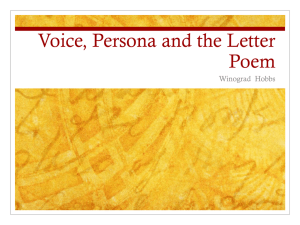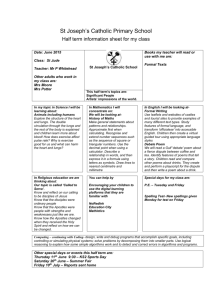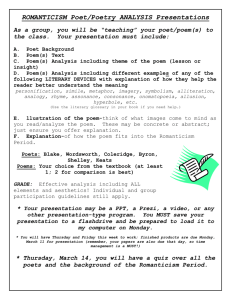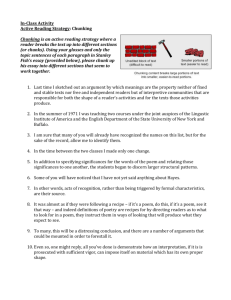Lesson Plan Two: Let the River Speak
advertisement
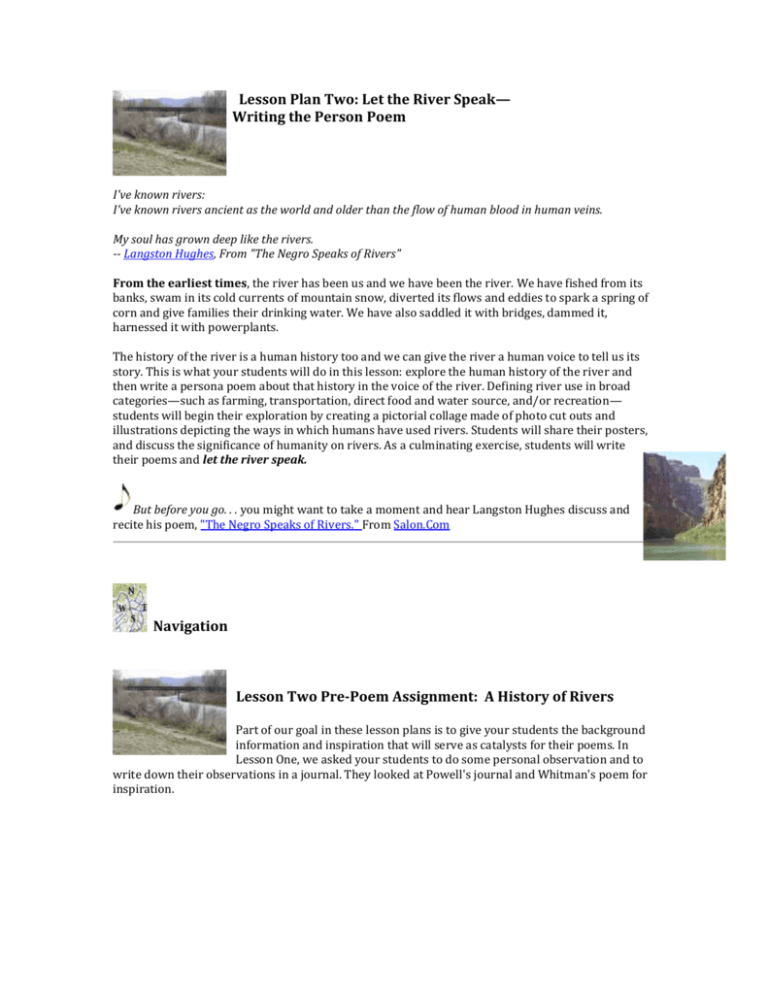
Lesson Plan Two: Let the River Speak— Writing the Person Poem I've known rivers: I've known rivers ancient as the world and older than the flow of human blood in human veins. My soul has grown deep like the rivers. -- Langston Hughes, From "The Negro Speaks of Rivers" From the earliest times, the river has been us and we have been the river. We have fished from its banks, swam in its cold currents of mountain snow, diverted its flows and eddies to spark a spring of corn and give families their drinking water. We have also saddled it with bridges, dammed it, harnessed it with powerplants. The history of the river is a human history too and we can give the river a human voice to tell us its story. This is what your students will do in this lesson: explore the human history of the river and then write a persona poem about that history in the voice of the river. Defining river use in broad categories—such as farming, transportation, direct food and water source, and/or recreation— students will begin their exploration by creating a pictorial collage made of photo cut outs and illustrations depicting the ways in which humans have used rivers. Students will share their posters, and discuss the significance of humanity on rivers. As a culminating exercise, students will write their poems and let the river speak. But before you go. . . you might want to take a moment and hear Langston Hughes discuss and recite his poem, "The Negro Speaks of Rivers." From Salon.Com Navigation Lesson Two Pre-Poem Assignment: A History of Rivers Part of our goal in these lesson plans is to give your students the background information and inspiration that will serve as catalysts for their poems. In Lesson One, we asked your students to do some personal observation and to write down their observations in a journal. They looked at Powell's journal and Whitman's poem for inspiration. Writing in their journals was their way of "priming the pump" for their poems, so to speak. We can help them prime the pump in other ways too. In this lesson, they will learn a bit about the history of the river and then go on a scavenger hunt for photos and pictures that they can turn into a "human history" collage of the river. The visual arts and poetry have been long time companions--the painter/photographer inspires the poet and the poet inspires the painter/photographer. Pre-Poem Resources and Assignment Instructions Creating the Collage: To begin the collage exercise, you will introduce to your students to "A Short History of Rivers" by Patrick McCully, author and staff member of International Rivers Network, an organization dedicated to saving rivers and their watersheds. Students will then brainstorm on the ways humans use rivers and collectively decide upon several categories for the human history of rivers. Groups will then choose a category (or all categories). Conduct a search for photos and pictures via books, magazines, and the WWW to create a human history of rivers collage, and then present their posters to the class. This will serve as the visual inspiration for their poems. Click on the following links for: " A Short History of Rivers," by Patrick McCully. * This short essay (3 pps) discusses the birth of rivers, their physical characteristics and how they relate to the land around them, and their role in human history. The essay is actually an excerpt from McCully's book, Silenced Rivers: The Ecology and Politics of Large Dams, 1996. (River of Words includes "A Short History of Rivers" in its K12 Watershed Explorer Curriculum. We suggest you print out the essay and hand it out to your students.) Resources for Lesson Two: Clicking on our Resource page for Lesson Two, you will find links to images categorized by Irrigation, Transportation, Food and Water Supply, and Recreation. Click on the Pre-Poem Assignment link below for: Recommendations for The Student Collage Assignment Lesson Two The Poem Assignment: Writing the Persona Poem What is a persona poem? I puddle up the neighborhood I make the mailman mad I wake the worm and spank the frog ... Excerpt from Spring Often a poet will take on the voice and life of an object or thing, a literary device known as "personification." A poem written entirely in the voice of that object or thing is called a “persona poem” (link to persona poem information on web) or "mask" poem. The “I” of the poem is not the poet, but rather the object or thing. Persona poems are written from the point of view of the object or thing, not from the poet’s. (A persona poem can also be written from the perspective of another person (often called a "dramatic monologue"—the main point of the persona poem for the poet is not to write from his or her own perspective.) Often poets will try to create a persona “character”: a distinct being with its own way of talking, its own Rain by J. Patrick Lewis vocabulary, its own tone. Writing a persona poem allows the poet unexpected freedom. Word choice and the way of putting words together in a line of poetry change to reflect the personality and history of the persona. Persona poems work best when the poet draws from personal observation, scientific fact and history to help create the voice and vision of the persona. Persona poems reveal what the object feels and thinks, what it remembers, hopes, and dreams. The poem should come out of a need for the object to tell its audience something. In this case, your students will be writing in the voice of the river. The river needs to tell the “you,” in this case, a contemporary person, something: a secret, a wish, a warning, a fear, or a hope. Perhaps it needs to tell the story of how it came to be what it is now. Your students can make that decision by drawing on what they learned from "A Short History of Rivers" and in creating their poster collages. The Poem Resources and Assignment Instructions Resources Spring Rain--Poem and explanation of the persona poem * by J. Patrick Lewis This link takes you to a clever and short poem written in the voice of the Spring Rain. It also includes a quick discussion of the persona poem and suggestions for getting your students started writing a persona poem by the children's poet, by Paul B. Janeczko. Old Elm Speaks Teacher Guide * by Kristine O'Connell G.orge, author of Old Elm Speaks: Tree Poems Especially for teachers with younger students, this might be an ideal site to begin an exploration into the persona or mask poem. "Old Elm Speaks Teacher Guide" offers a short explanation of what a mask poem is, ideas to get the younger student going through exercises in writing tree poems, and a lovely sample persona poem: Old Elm Speaks Assignment What might the river sound like? What does it feel like to be the river? What secrets does the river know that we do not know? What might the river want to tell us? These questions are the sparks for poems written in the voice of the river. Would the river speak in long lines? Short lines? What sounds might the river make when it speaks? Share the sample river persona poems in the course with your student, and then ask students to use the information they gathered for their poster collages about the river to write their own river personal poems. Suggest the following poem rules: 1. The title of the poem must indicate that a river is speaking. 2. The river must speak for itself, using “I.” 3. The river must speak to its audience—us--, using “you.” 4. The river must have something it wants to tell us: a secret, a complaint, a desire or wish. 5. The poem should be at least 10 lines long. Science Extension Activity: Water Use This activity is very similar to this lesson’s pre-assignment activity in that it asks students to make a collage. Students will make collages based on research they have done on water use in each of Colorado’s eight major river basins. However, it has more specific reference to Colorado’s rivers and water uses that will help students understand how water is used in their home stateThe eight major river basins in Colorado are: 1) Green River Basin 2) North Platte River Basin 3) South Platte River Basin 4) Repulbican River Basin 5) Arkansas River Basin 6) Rio Grande River Basin 7) San Juan River and Dolores River Basins 8) Colorado and Gunnison River Basins Divide the class into eight different groups, each representing one of Colorado’s major river basins. Use the fact sheets from the Colorado Water Conservation Board to guide students in their work. Have each group create a collage representing the major water uses and landscapes from that basin. Remind students to think of the different types of water users. While humans rely on the rivers, so do the plants and animals. For example, if a group is focusing on the Yampa River, possible pictures would represent recreation (skiing, hiking, kayaking), agriculture (ranching and farming), and industry (coal, gas, and oil mining) uses. Once the collages are completed, have the groups present their findings to the class by identifying the various uses that are unique to the basin in question. Follow-up questions may include: volume, etc.) conclusions can they come to about the state’s water uses? Science Resource Links Colorado Foundation for Water Education’s Citizen’s Guide: Where Does Your Water Come From. www.cfwe.org Helps students recognize the watershed in which they live and where the water they drink comes from. The guide also discusses delivery systems that bring water from the Western Slope to the Front Range. Colorado Water Conservation Board www.cwcb.state.co.us The Colorado Water Conservation Board works to conserve, develop, protect and manage Colorado's water for present and future generations. Their web site provides information on water education resources such as a video presentation (kiosk) and an educational resource guide. U.S. Environmental Protection Agency http://www.epa.gov/ebtpages/water.html Follow the “Surf Your Watershed” link from this page to get up-to-date information about your specific watershed. U.S. Geological Survey Website http://www.usgs.gov/state/state.asp?State=CO This site provides real-time information about streamflow conditions, flooding, groundwater, and drought. You can manipulate data to produce various graphs and charts to represent the characteristics of the state’s streams and rivers. LESSON TWO POEM SAMPLES Below you'll find two examples of a river persona poem from the 2002 and 2004 Colorado River of Words Poetry contest. As your students write their persona poems, please submit the best to the Teacher Corner discussion link so we can continue to build a base of Colorado poetry examples. I AM THE HEADWATERS I am the headwaters plunging, and racing down rocky walls, I am the river foaming, rushing over rocks worn smooth at my touch, I am home to the river otter, swimming playfully or snoozing on my banks, I am the carver of the canyons, I am the home of the fish, small and sleek or big and fat, I am the playground of the ducks, I know where I am going and I will get there, I flow slowly, I rush swiftly, I am the commander of the floods, I guide the trickling streams, I am as clear as the wind in the mountains, I never stop my journey to the salty sea, where I tickle the brightly colored fishes, I am the greatest traveler in the world, if you don’t believe me try and beat me, for I am the river. Katie Post, Grade 6, Logan School, Denver Teacher: Jamie Newton 2002 RIVER OF WORDS POETRY CONTEST: COLORADO WINNER, 1st Prize River of Song I was untamed. The only ear That could hear My pulsing cry Were primitive animals Who came to me For a drink Of my nectar. I lived in a cycle Of rain and snow bloating me. Sun and earth shrinking me, I was happy. I was whole. My tributaries Would come to me. Telling me stories Of their travels. I orged on. Made stories of my own. But time caught up to me. The sleek salmon, My brethren My children Were caught with a net or hook. Reeled in. I orged on Tried to ignore The pain that enveloped me. I was silent, ignored. Taken for granted. I was tamed. Hannah O’Neill Sixth Grade, Teacher: Jamie Newton Logan School Denver, Colorado 2004 Honorable Mention, Colorado River of Words Poetry Contest For the Young The persona poem can be a fun way to get younger students thinking imaginatively about the world around them. Depending on the age, you might want to encourage your students to draw pictures of fun things that people do on a river. You can use the "A Short History of River" essay to help them understand how rivers begin and end and the important part they have played and still play in our lives. Recommended Resources Old Elm Speaks Teacher Guide by Kristine O'Connell Gorge, author of Old Elm Speaks: Tree Poems Especially for teachers with younger students, this might be an ideal site to begin an exploration into the persona or mask poem. "Old Elm Speaks Teacher Guide" offers a short explanation of what a mask poem is, ideas to get the younger student going through exercises in writing tree poems, and a lovely short and sweet sample persona poem: Old Elm Speaks. (Scroll down to find the poem: the link is somewhat buried.)


